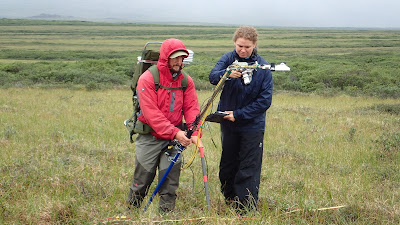The NGEE Arctic project (http://ngee-arctic.ornl.gov/) has
enjoyed five successful field seasons working at our research site near Barrow,
Alaska. This year – thanks to the hard work of many people – we begin a new
chapter in our efforts to integrate field and laboratory studies in support of
advancing climate model development for the Arctic. Our team is expanding to
include field sites outside Nome on the Seward Peninsula in western Alaska.
The NGEE Arctic team will, working first at the Teller site,
use an array of geophysical approaches to establish interactions between permafrost
and bedrock, and to examine the consequences of those interactions to watershed
hydrology. Complementary studies of vegetation, biogeochemistry, and energy
balance will help inform our understanding of Arctic tundra and provide
insights for developing multi-scale numerical models for inclusion into climate
models. Our goal is to better understand the fate of frozen soil organic matter
(i.e., the permafrost carbon cycle) in a warming climate and incorporate
critical feedbacks into models. We were fortunate to begin collecting initial datasets
last year and will continue to expand on those with increasingly detailed field
and modeling investigations of the Teller Road watershed.
The next three weeks will be a productive time for our team.
Our planning has laid a foundation that we will continue to build upon,
ensuring that our interdisciplinary science delivers on expectations and does
so in a safe and efficient manner. We are thankful that while working thousands
of miles away from our home institutions can be challenging, our team has the
support and cooperation of people and facilities like Bob, Gretchen, Claudia,
and others at the UAF Northwest Campus in Nome.
While the next few weeks will be busy ones, I’ll do my best
to provide periodic updates on the science being conducted by our team and how those
research results and acquired knowledge is incorporated into models, including global-scale
Earth System Models.







